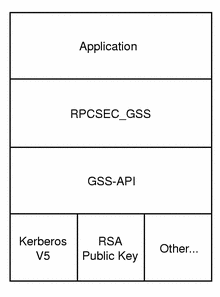The RPCSEC_GSS API
The RPCSEC_GSS security flavor allows ONC RPC applications to take advantage of the features of GSS-API. RPCSEC_GSS sits "on top" of the GSS-API layer as follows:
Figure 4-1 GSS-API and RPCSEC_GSS Security Layers

Using the programming interface for RPCSEC_GSS, ONC RPC applications can specify:
- mechanism
-
A security paradigm. Each kind of security mechanism offers a different kind of data protection, as well as one or more levels of data protection. In this case, any security mechanism supported by the GSS-API (Kerberos V5, RSA public key, and so forth).
- security service
-
Either privacy or integrity (or neither). The default is integrity The service is mechanism-independent.
- QOP
-
Quality of Protection. The QOP specifies the type of cryptographic algorithm to be used to implement privacy or integrity services. Each security mechanism can have one or more QOPs associated with it.
Applications can obtain lists of valid QOPs and mechanisms through functions provided by RPCSEC_GSS. (See "Miscellaneous Functions".) Developers should avoid hard-coding mechanisms and QOPs into their applications, so that the applications will not need to be modified to use new or different mechanisms and QOPs.
Note -
Historically, "security flavor" and "authentication flavor" have meant the same thing. With the introduction of RPCSEC_GSS, "flavor" now has a somewhat different sense. A flavor can now include a service (integrity or privacy) along with authentication, although currently RPCSEC_GSS is the only flavor that does.
Using RPCSEC_GSS, ONC RPC applications establish a security context with a peer, exchange data, and destroy the context, just as they do with other flavors. Once a context is established, the application can change the QOP and service for each data unit sent.
For more information on RPCSEC_GSS, including RPCSEC_GSS data types, see the rpcsec_gss(3N) man page.
- © 2010, Oracle Corporation and/or its affiliates
